 Uncanny X-Men #1 (Legacy #620) — Writers: Ed Brisson, Matthew Rosenberg and Kelly Thompson; Art: Mahmud Asrar; Colors: Rachelle Rosenberg
Uncanny X-Men #1 (Legacy #620) — Writers: Ed Brisson, Matthew Rosenberg and Kelly Thompson; Art: Mahmud Asrar; Colors: Rachelle Rosenberg
Avengers #10 (Legacy #700) — Writer: Jason Aaron; Art: David Marquez and Ed McGuinness with Frazer Irving, Adam Kubert and Andrea Sorrentino; Colors: Justin Ponsor, Erick Arciniega, Frazer Irving, Matthew Wilson and Giada Marchisio
The Black Order #1 (of 5) — Writer: Derek Landy; Pencils: Philip Tan; Inks: Marc Deering, Guillermo Ortega and Le Beau Underwood; Colors: Jay David Ramos
Uncanny X-Men #1 is a relaunch of that bedrock Marvel title, and it’s following the same pattern as the Avengers relaunch of last year: start with a long (10-issue) weekly 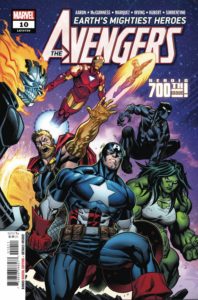 “Disassembled” event to clear out the undergrowth and get the team back to basics, and then go from there. As such, there are a bunch of characters interacting in this first issue, mostly looking for a vanished Kitty Pryde; Mahmud Asrar supplies realistic superhero-styled art that’s good at getting all the faces and figures right, and has some effective page compositions. In addition, there are a number of back-up stories — Bishop by Matthew Rosenberg and Mirko Colak; Jean Grey by Kelly Thompson and Ibraim Roberson, and Armor/Anole by Ed Brisson, Mark Bagley and Andrew Hennessy — that tie into the main story. If you are or have ever been an X-fan, you’ll probably want this. Meanwhile, over in Avengers, there’s a giant-size 700th-anniversary that continues the current storyline of a now-more-deadly Namor telling the surface world to stay the hell out of his oceans; that culminates in a three-way fight between him, the Avengers, and a new Russian team of superheroes. There are also back-up stories, all written by main writer
“Disassembled” event to clear out the undergrowth and get the team back to basics, and then go from there. As such, there are a bunch of characters interacting in this first issue, mostly looking for a vanished Kitty Pryde; Mahmud Asrar supplies realistic superhero-styled art that’s good at getting all the faces and figures right, and has some effective page compositions. In addition, there are a number of back-up stories — Bishop by Matthew Rosenberg and Mirko Colak; Jean Grey by Kelly Thompson and Ibraim Roberson, and Armor/Anole by Ed Brisson, Mark Bagley and Andrew Hennessy — that tie into the main story. If you are or have ever been an X-fan, you’ll probably want this. Meanwhile, over in Avengers, there’s a giant-size 700th-anniversary that continues the current storyline of a now-more-deadly Namor telling the surface world to stay the hell out of his oceans; that culminates in a three-way fight between him, the Avengers, and a new Russian team of superheroes. There are also back-up stories, all written by main writer 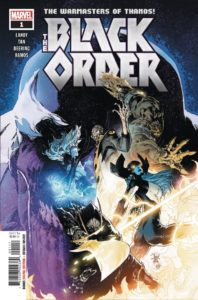 Jason Aaron, involving the Ghost Rider and Odin (by Frazer Irving), Loki and Wolverine (which proceeds directly from the last page of last week’s Infinity Wars #5, and has some impressive art by Adam Kubert), and the Janet Van Dyne Wasp, who encounters an intriguing last-page guest star (by Andrea Sorrentino); as with Uncanny X-Men, there’s plenty here for fans of the group. The other Marvel debut is Black Order, a mini-series involving that group of Thanos hangers-on and general cosmic bad guys; Philip Tan supplies appropriately-grim, superhero-stylized art, and I liked Derek Landy’s narrative focus on the group leader, Corvus Grave, who in between murdering various sentients obsesses over whether anyone appreciates his sense of humor: a tactic that’s just weird enough to work.
Jason Aaron, involving the Ghost Rider and Odin (by Frazer Irving), Loki and Wolverine (which proceeds directly from the last page of last week’s Infinity Wars #5, and has some impressive art by Adam Kubert), and the Janet Van Dyne Wasp, who encounters an intriguing last-page guest star (by Andrea Sorrentino); as with Uncanny X-Men, there’s plenty here for fans of the group. The other Marvel debut is Black Order, a mini-series involving that group of Thanos hangers-on and general cosmic bad guys; Philip Tan supplies appropriately-grim, superhero-stylized art, and I liked Derek Landy’s narrative focus on the group leader, Corvus Grave, who in between murdering various sentients obsesses over whether anyone appreciates his sense of humor: a tactic that’s just weird enough to work.
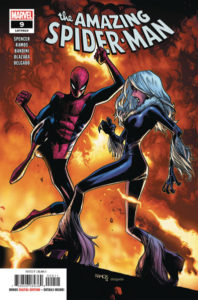 Amazing Spider-Man #9 (Legacy #810) — Writer: Nick Spencer; Pencils: Humberto Ramos and Michele Bandini; Inks: Victor Olazaba and Michele Bandini; Colors: Edgar Delgado and Erick Arciniega
Amazing Spider-Man #9 (Legacy #810) — Writer: Nick Spencer; Pencils: Humberto Ramos and Michele Bandini; Inks: Victor Olazaba and Michele Bandini; Colors: Edgar Delgado and Erick Arciniega
Peter Parker: The Spectacular Spider-Man #312 — Writer: Sean Ryan; Art: Juan Frigeri; Colors: Jason Keith
Spider-Geddon: Vault of Spiders #2 (of 2) — Creators: Various
 Spider-Man/Deadpool #41 — Writer: Robbie Thompson; Art: Matt Horak; Colors: Brian Reber
Spider-Man/Deadpool #41 — Writer: Robbie Thompson; Art: Matt Horak; Colors: Brian Reber
Four titles from the Spider-verse this week: the flagship, Amazing Spider-Man, features an encounter/team-up with the Black Cat, as they take on a Thieves’ Guild that’s been targeting superheroes, stealing Tony Stark’s armor, old Avengers costumes, Spidey’s webshooters, etc. (because they can sell it all for tons of money to collector’s  on the Marvel universe equivalent of eBay); that’s a cool concept, and as always Humberto Ramos’s art, especially on the main characters, makes it easy to like. Peter Parker, the Spectacular Spider-Man has the second of a three-part Spider-Geddon tie-in fight with the Inheritor Morlun (Parker isn’t part of that current mini-series, leaving the spotlight on all the other spider-avatars, so this is the place to see his contribution), while Vault of Spiders offers short tales about some of those other alternate versions: one with “Spiders-Man,” where the costume is inhabited by
on the Marvel universe equivalent of eBay); that’s a cool concept, and as always Humberto Ramos’s art, especially on the main characters, makes it easy to like. Peter Parker, the Spectacular Spider-Man has the second of a three-part Spider-Geddon tie-in fight with the Inheritor Morlun (Parker isn’t part of that current mini-series, leaving the spotlight on all the other spider-avatars, so this is the place to see his contribution), while Vault of Spiders offers short tales about some of those other alternate versions: one with “Spiders-Man,” where the costume is inhabited by  hundreds of actual spiders, by Cullen Bunn, Mark Bagley and Andrew Hennessy; a tongue-in-cheek one with Aunt May as the heroine, written by Squirrel Girl scribe Ryan North and with art by David R. Williams; and one with Captain George Stacy in the suit, by Geoffrey Thorne and Todd Harris. Then, there’s Spider-Man/Deadpool, whose merc/hero buddy-movie combo is still going strong, with those two title frenemies on a road trip and fighting giant insects in the Southwestern desert (including one or two shots of Arizona scenery); if you prefer your superheroics snarky and with a wink (and lots of fourth-wall breaking, as Wade tries to tell Pete about all the readers watching them), then this is the comic for you.
hundreds of actual spiders, by Cullen Bunn, Mark Bagley and Andrew Hennessy; a tongue-in-cheek one with Aunt May as the heroine, written by Squirrel Girl scribe Ryan North and with art by David R. Williams; and one with Captain George Stacy in the suit, by Geoffrey Thorne and Todd Harris. Then, there’s Spider-Man/Deadpool, whose merc/hero buddy-movie combo is still going strong, with those two title frenemies on a road trip and fighting giant insects in the Southwestern desert (including one or two shots of Arizona scenery); if you prefer your superheroics snarky and with a wink (and lots of fourth-wall breaking, as Wade tries to tell Pete about all the readers watching them), then this is the comic for you.
 Thor #7 (Legacy #713) — Writer: Jason Aaron; Art: Tony Moore; Colors: John Rauch
Thor #7 (Legacy #713) — Writer: Jason Aaron; Art: Tony Moore; Colors: John Rauch
Fantastic Four #3 (Legacy #648) — Writer: Dan Slott; Art: Sara Pichelli and Nico Leon; Colors: Marte Gracia
Cosmic Ghost Rider #5 (of 5) — Writer: Donny Cates; Art: Dylan Burnett; Colors: Antonio Fabela
Venom #8 (Legacy #173) — Writer: Donny Cates; Art:  Iban Coello; Colors: Andres Mossa
Iban Coello; Colors: Andres Mossa
Unbeatable Squirrel Girl 38 — Writer: Ryan North; Art: Derek Charm; Colors: Rico Renzi
Unstoppable Wasp #2 (Legacy #10) — Writer: Jeremy Whitley; Art/Colors: Gurihiru
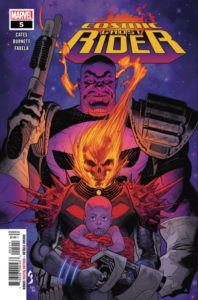 Domino #8 — Writer: Gail Simone; Art: David Baldeon; Colors: Jesus Aburtov
Domino #8 — Writer: Gail Simone; Art: David Baldeon; Colors: Jesus Aburtov
Thor has a one-shot story about a young Thunder God falling hard for a mortal Viking warrior maiden called Erika the Red (“Red Sonya” being, presumably, already taken), under the machinations of his father and Loki; artist Tony Moore and colorist John Rauch combine to give it an appealing folk-tale-ish quality. Fantastic Four  finishes its first arc (smartly, a short one), with every hero who’s ever been a member of the quartet (and it turns out that’s a lot) facing off against the cosmic-level Griever; Dan Slott and Sara Pichelli give fans cause for optimism in this inaugural story, getting the FF back together and in classical form efficiently and attractively, with a number of nods to previous issues and themes. Donny Cates, who seems to be writing most of Marvel’s comics lately, has two books out this week; Cosmic Ghost Rider ends its run about
finishes its first arc (smartly, a short one), with every hero who’s ever been a member of the quartet (and it turns out that’s a lot) facing off against the cosmic-level Griever; Dan Slott and Sara Pichelli give fans cause for optimism in this inaugural story, getting the FF back together and in classical form efficiently and attractively, with a number of nods to previous issues and themes. Donny Cates, who seems to be writing most of Marvel’s comics lately, has two books out this week; Cosmic Ghost Rider ends its run about 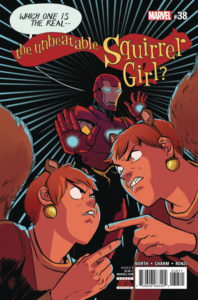 that character’s attempt to end the threat of Thanos by going back in time and raising the Titan from childhood, an idea that, as you might expect, doesn’t end well — however, CGR himself has proven so popular that the book ends with a plug for a new incarnation of Guardians of the Galaxy, in which he figures prominently. Venom #8, also by Cates, sees Eddie Brock, with his symbiote damaged and possibly brain-dead, captured by the Ultimate-universe version of Reed Richards called the Maker (part of the fun of writing these
that character’s attempt to end the threat of Thanos by going back in time and raising the Titan from childhood, an idea that, as you might expect, doesn’t end well — however, CGR himself has proven so popular that the book ends with a plug for a new incarnation of Guardians of the Galaxy, in which he figures prominently. Venom #8, also by Cates, sees Eddie Brock, with his symbiote damaged and possibly brain-dead, captured by the Ultimate-universe version of Reed Richards called the Maker (part of the fun of writing these  reviews each week is writing sentences like that….); there’s at least one revelation about anyone who’s ever “worn” a symbiote, and a touching tribute to former, and now “dead,” wearer Flash Thompson: just the kind of stuff Cates is so good at, and which has made him an increasingly-popular writer. The Marvel women seem to have some of the freshest comics lately, and this week offers three examples: the first is Squirrel Girl, the flagship and inspiration for many of the others, with Doreen and friends trying to solve the mystery of an imposter, and also dealing with a possibly-fake Tony Stark; Ryan North and Derek Charm make it just as fun, funny
reviews each week is writing sentences like that….); there’s at least one revelation about anyone who’s ever “worn” a symbiote, and a touching tribute to former, and now “dead,” wearer Flash Thompson: just the kind of stuff Cates is so good at, and which has made him an increasingly-popular writer. The Marvel women seem to have some of the freshest comics lately, and this week offers three examples: the first is Squirrel Girl, the flagship and inspiration for many of the others, with Doreen and friends trying to solve the mystery of an imposter, and also dealing with a possibly-fake Tony Stark; Ryan North and Derek Charm make it just as fun, funny 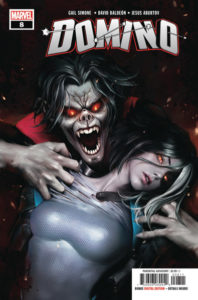 and charming as always. Unstoppable Wasp is one of those “others,” with a similar cartoony art style, similar humor, and an even-closer focus on girls and STEM-centered science/tech careers mixed in with the action; despite that female YA focus, almost every superhero-comic reader will find its nods to continuity and character relationships easy to like, too. Domino is tilted more towards those older, regular fans, with even more continuity nods and action, as the luck-based mutant and her friends fight, and then team up, with Michael Morbius against a world-threatening vampire threat; Gail Simone offers her usual blend of tough-minded plots and characterization, female-powered friendship themes, and offbeat comedy.
and charming as always. Unstoppable Wasp is one of those “others,” with a similar cartoony art style, similar humor, and an even-closer focus on girls and STEM-centered science/tech careers mixed in with the action; despite that female YA focus, almost every superhero-comic reader will find its nods to continuity and character relationships easy to like, too. Domino is tilted more towards those older, regular fans, with even more continuity nods and action, as the luck-based mutant and her friends fight, and then team up, with Michael Morbius against a world-threatening vampire threat; Gail Simone offers her usual blend of tough-minded plots and characterization, female-powered friendship themes, and offbeat comedy.
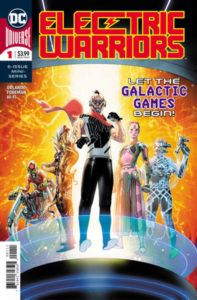 Electric Warriors #1 (of 6) — Writer: Steve Orlando; Art: Travis Foreman; Colors: Hi-Fi
Electric Warriors #1 (of 6) — Writer: Steve Orlando; Art: Travis Foreman; Colors: Hi-Fi
Mister Miracle #12 (of 12) — Writer: Tom King; Art/Colors: Mitch Gerads
Superman #5 — Writer: Brian Michael Bendis; Pencils: Ivan Reis; Inks: Joe Prado and Oclair Albert; Colors: Alex Sinclair
Electric Warriors uses the title of that obscure late-’80s DC comic by Doug Moench and Jim Baikie, but little else. It’s actually more tied into Kamandi continuity, set a couple of 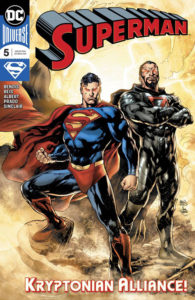 hundred years after that book, on an Earth where humans and sentient animals now live in uneasy partnership; one of each group is selected to be transformed into the title characters, planetary representatives who end up fighting in a galactic arena to settle their worlds’ diplomatic disputes with other, alien cultures. This is a lot to cover in one issue, but it repays multiple readings, and generates enough interest to check out at least another installment or two. The biggest book of the week, though, is the conclusion of Tom King and Mitch Gerads’s Mister Miracle. I’ve been guessing since the first issue that everything’s actually taking place in Scott Free’s head, and that turns out to be sort-of true, but the resolution goes in
hundred years after that book, on an Earth where humans and sentient animals now live in uneasy partnership; one of each group is selected to be transformed into the title characters, planetary representatives who end up fighting in a galactic arena to settle their worlds’ diplomatic disputes with other, alien cultures. This is a lot to cover in one issue, but it repays multiple readings, and generates enough interest to check out at least another installment or two. The biggest book of the week, though, is the conclusion of Tom King and Mitch Gerads’s Mister Miracle. I’ve been guessing since the first issue that everything’s actually taking place in Scott Free’s head, and that turns out to be sort-of true, but the resolution goes in 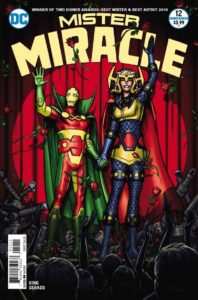 surprising and affecting directions. What is happiness? Where do our responsibilities lie? What’s real and what isn’t, and in what ways does it matter? Those are big questions, without solid answers, and King navigates them expertly; he’s said there’s a lot of autobiography in this series, and it works to its benefit here at the end. Superman reaches the penultimate issue of Brian Bendis’s first arc, with Earth out of the Phantom Zone (after an amusing hiccup or two) but Kal-El still trapped there — and encountering a surprising ally; the story’s twists and turns, the solid art, and the deft characterization should make this a perennial best-seller in trade form — unless they screw up the ending in two weeks….
surprising and affecting directions. What is happiness? Where do our responsibilities lie? What’s real and what isn’t, and in what ways does it matter? Those are big questions, without solid answers, and King navigates them expertly; he’s said there’s a lot of autobiography in this series, and it works to its benefit here at the end. Superman reaches the penultimate issue of Brian Bendis’s first arc, with Earth out of the Phantom Zone (after an amusing hiccup or two) but Kal-El still trapped there — and encountering a surprising ally; the story’s twists and turns, the solid art, and the deft characterization should make this a perennial best-seller in trade form — unless they screw up the ending in two weeks….
 The Terrible Elisabeth Dumn Against the Devils In Suits #1 (of 1) — Writer/Artist: Arabson Assis; English translation: James Robinson; Colors: Anderson Cabral
The Terrible Elisabeth Dumn Against the Devils In Suits #1 (of 1) — Writer/Artist: Arabson Assis; English translation: James Robinson; Colors: Anderson Cabral
Firefly #1 (of 6) — Writer: Greg Pak; Art: Dan McDaid; Colors: Marcelo Costa
Dr. Horrible: Best Friends Forever #1 (of 1) — Writer: Joss Whedon; Art: Jose Maria Beroy and Sara Soler; Colors: Dan Jackson
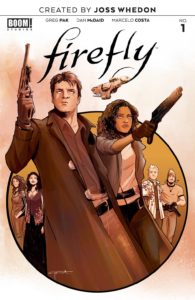 Bitter Root #1 — Writers: David F. Walker and Chuck Brown; Art: Sanford Greene; Colors: Rico Renzi and Sanford Greene
Bitter Root #1 — Writers: David F. Walker and Chuck Brown; Art: Sanford Greene; Colors: Rico Renzi and Sanford Greene
The Terrible Elisabeth Dumn Against The Devils In Suits sounds like it would be, in fact, terrible, but is actually quite good: it’s by a Brazilian artist/writer, Arabson Assis, and while it’s set in his country it feels like a Mississippi-delta legend, with the title character a girl whose father, years ago, made a deal with the Devil; when he comes to collect, the father tries to tempt him with his daughter, whom he claims is “untamable.” This turns out to be true; she partners up with an old blues musician with his own 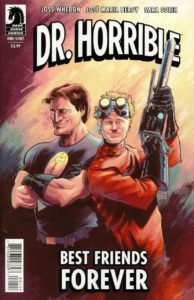 history, and they proceed to kick the Devil’s ass. Arabson (he goes by just the first name) is marvelously grotesque in his people, elegaic in his country scenes, and chilling in his supernatural action. As an oversized one-shot (the better to show off the art), this is an almost-perfect comic book. Two other indy debuts this week, Firefly and Dr. Horrible, are from the Joss Whedonverse; his connection to Firefly is only as an advisor, but Greg Pak has the characters down pat, and puts them through their paces well, while Dan McDaid makes everyone recognizable and clear; fans of the series, and the movie, should like it a lot. Dr. Horrible is a one-shot written by Whedon, partly in celebration of the tenth anniversary of that ground-breaking three-part
history, and they proceed to kick the Devil’s ass. Arabson (he goes by just the first name) is marvelously grotesque in his people, elegaic in his country scenes, and chilling in his supernatural action. As an oversized one-shot (the better to show off the art), this is an almost-perfect comic book. Two other indy debuts this week, Firefly and Dr. Horrible, are from the Joss Whedonverse; his connection to Firefly is only as an advisor, but Greg Pak has the characters down pat, and puts them through their paces well, while Dan McDaid makes everyone recognizable and clear; fans of the series, and the movie, should like it a lot. Dr. Horrible is a one-shot written by Whedon, partly in celebration of the tenth anniversary of that ground-breaking three-part  musical web series; it begins with the title doctor and his nemesis, Captain Hammer, as best buddies, and goes from there. If you were a fan of the original, you’ll like it a lot; if not, you don’t need to find copies of it (or of the couple of one-shots published in the late ’00s, and written by Whedon brother Zack) in order to enjoy this comic, but you probably should anyway; they hold up remarkably well. Bitter Root is a horror comic, set in 1920s Harlem, about a family of (now) African-Americans who hunt demons, in a struggle that stretches back to the dawn of civilization; as you might expect, themes of racism play a big part in it too, although at heart it’s a monster-hunting book, with a vivid group of main characters.
musical web series; it begins with the title doctor and his nemesis, Captain Hammer, as best buddies, and goes from there. If you were a fan of the original, you’ll like it a lot; if not, you don’t need to find copies of it (or of the couple of one-shots published in the late ’00s, and written by Whedon brother Zack) in order to enjoy this comic, but you probably should anyway; they hold up remarkably well. Bitter Root is a horror comic, set in 1920s Harlem, about a family of (now) African-Americans who hunt demons, in a struggle that stretches back to the dawn of civilization; as you might expect, themes of racism play a big part in it too, although at heart it’s a monster-hunting book, with a vivid group of main characters.
 Jook Joint #2 (of 5) — Writer: Tee Franklin; Art: Alitha E. Martinez; Colors: Shari Chankhamma
Jook Joint #2 (of 5) — Writer: Tee Franklin; Art: Alitha E. Martinez; Colors: Shari Chankhamma
Cemetery Beach #3 (of 7) — Writer: Warren Ellis; Art/Colors: Jason Howard
Mage: The Hero Denied #13 (of 15) — Writer/Artist: Matt Wagner; Colors: Brennan Wagner
Jook Joint is very much a #MeToo-era comic, complete with trigger warnings for sexual assault and domestic violence on the first page; it’s about an early-20th-century Louisiana brothel run by a voodoo priestess, whose minions take terrible revenge on any john stupid enough to 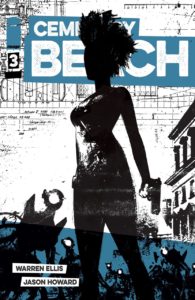 ignore the rules and disrespect or assault the girls (she also runs a side business counseling local women whose husbands or boyfriends are battering or raping them, with similar vengeance enacted). All of this is a little too on the nose, one of those stories where 90% of the men have to be horrible, to justify their bloody fates, but it’s redeemed by Alitha E. Martinez’s art; she has a little of the early Joelle Jones in her style, and this second issue is noticeably more confident than the first, with some striking figure work and composition: she bears watching. Cemetery Beach is a lot like Warren Ellis’s previous Two-Step: a non-stop chase scene with two strangers who quickly bond in their shared competence, bloody-mindedness and mutual attraction; in this case, it’s an Earth spy scouting out a long-ago-
ignore the rules and disrespect or assault the girls (she also runs a side business counseling local women whose husbands or boyfriends are battering or raping them, with similar vengeance enacted). All of this is a little too on the nose, one of those stories where 90% of the men have to be horrible, to justify their bloody fates, but it’s redeemed by Alitha E. Martinez’s art; she has a little of the early Joelle Jones in her style, and this second issue is noticeably more confident than the first, with some striking figure work and composition: she bears watching. Cemetery Beach is a lot like Warren Ellis’s previous Two-Step: a non-stop chase scene with two strangers who quickly bond in their shared competence, bloody-mindedness and mutual attraction; in this case, it’s an Earth spy scouting out a long-ago-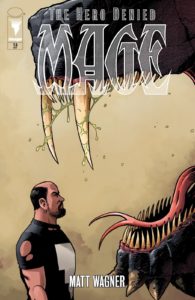 colonized-and-forgotten planet, and the murderous, jailed rebel girl he frees. The actual chases and battles are very well worked out, and Jason Howard has already demonstrated in Trees that he can draw anything Ellis comes up with and make it look great; get all seven of these and read them all at once, and I bet it’ll be a zippy, fun ride. Mage is another comic that should do well in collected form (its first two volumes are perennial sellers), although almost no one seems to be buying it in individual issues. Matt Wagner’s stuff is always worth a look, though, and this is by far his most personal work; while you’re not likely to start a 15-issue mini-series on its 13th issue, you really ought to reserve a copy of the trade….
colonized-and-forgotten planet, and the murderous, jailed rebel girl he frees. The actual chases and battles are very well worked out, and Jason Howard has already demonstrated in Trees that he can draw anything Ellis comes up with and make it look great; get all seven of these and read them all at once, and I bet it’ll be a zippy, fun ride. Mage is another comic that should do well in collected form (its first two volumes are perennial sellers), although almost no one seems to be buying it in individual issues. Matt Wagner’s stuff is always worth a look, though, and this is by far his most personal work; while you’re not likely to start a 15-issue mini-series on its 13th issue, you really ought to reserve a copy of the trade….



